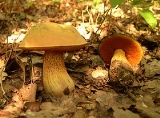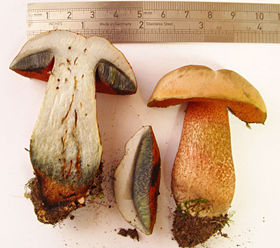
Boletus luridus
Encyclopedia
Boletus luridus, commonly known as the lurid bolete, is a fungus
Fungus
A fungus is a member of a large group of eukaryotic organisms that includes microorganisms such as yeasts and molds , as well as the more familiar mushrooms. These organisms are classified as a kingdom, Fungi, which is separate from plants, animals, and bacteria...
of the bolete family
Boletaceae
Boletaceae are a family of mushrooms, primarily characterized by developing their spores in small pores on the underside of the mushroom, instead of gills, as are found in agarics. Nearly as widely distributed as agarics, they include the Cep or King Bolete , much sought after by mushroom hunters...
, found in deciduous woodlands in Europe and eastern North America. Fruiting bodies arise in summer and autumn and may be common. It is a solid bolete with an olive-brown cap, orange pores and stout ochre stem patterned with a reddish meshwork. Like several other red-pored boletes, it stains blue when bruised or cut. Though edible when cooked, it can cause gastric upset when raw and be confused with the poisonous Boletus satanas, though satanas has a pale cap.
Taxonomy
Boletus luridus was described by Jacob Christian SchaefferJacob Christian Schäffer
Jakob or Jacob Christian Gottlieb Schäffer or Schäffern was a German dean, professor, botanist, mycologist, entomologist, ornithologist and inventor.-Biography:...
in 1774 and still bears its original name. Its specific epithet is the Latin
Latin
Latin is an Italic language originally spoken in Latium and Ancient Rome. It, along with most European languages, is a descendant of the ancient Proto-Indo-European language. Although it is considered a dead language, a number of scholars and members of the Christian clergy speak it fluently, and...
adjective luridus, 'sallow'. The American common name is lurid bolete. Both it and Boletus satanas are known as ayimantari 'bear mushroom' in Eastern Turkey.
Description
B.luridus is a stout fungus with a yellow-olive to olive-brown convex cushion-shaped capPileus (mycology)
The pileus is the technical name for the cap, or cap-like part, of a basidiocarp or ascocarp that supports a spore-bearing surface, the hymenium. The hymenium may consist of lamellae, tubes, or teeth, on the underside of the pileus...
that can reach 20 cm (8 in) in diameter. The cap surface is tomentose
Tomentose
Tomentose is a term used to describe plant hairs that are flattened and matted, forming a woolly coating known as tomentum. Often the hairs are silver or gray-colored...
(velvety), becoming smoother with old age, and sticky in wet weather. It has free orange or yellowish pores and yellow tubes underneath. The thick stem
Stipe (mycology)
thumb|150px|right|Diagram of a [[basidiomycete]] stipe with an [[annulus |annulus]] and [[volva |volva]]In mycology a stipe refers to the stem or stalk-like feature supporting the cap of a mushroom. Like all tissues of the mushroom other than the hymenium, the stipe is composed of sterile hyphal...
is colored with a red meshlike pattern on a paler ochre background. The flesh is yellowish, with red marks in the cap, and stains dark blue when bruised or broken. There is a faint sour smell and the taste is described as mild. The spore dust is olive coloured. The mycelium
Mycelium
thumb|right|Fungal myceliaMycelium is the vegetative part of a fungus, consisting of a mass of branching, thread-like hyphae. The mass of hyphae is sometimes called shiro, especially within the fairy ring fungi. Fungal colonies composed of mycelia are found in soil and on or within many other...
is an unusual yellow colour.
B. satanas is larger, has a pale cap and a putrid smell at times.

Distribution and habitat
The fungus grows in association with deciduousDeciduous
Deciduous means "falling off at maturity" or "tending to fall off", and is typically used in reference to trees or shrubs that lose their leaves seasonally, and to the shedding of other plant structures such as petals after flowering or fruit when ripe...
trees such as oak, birch and beech on calcareous
Calcareous
Calcareous is an adjective meaning mostly or partly composed of calcium carbonate, in other words, containing lime or being chalky. The term is used in a wide variety of scientific disciplines.-In zoology:...
(chalky) soils, from June to November after summer rains. It may occur in parks near a single tree, though it will not be found in acidic soils. It is widespread in Europe, east to the Black Sea region and eastern Anatolia
Anatolia
Anatolia is a geographic and historical term denoting the westernmost protrusion of Asia, comprising the majority of the Republic of Turkey...
in Turkey
Turkey
Turkey , known officially as the Republic of Turkey , is a Eurasian country located in Western Asia and in East Thrace in Southeastern Europe...
, as well as in the Eastern United States and Canada. It has been recorded from La Malinche National Park
La Malinche National Park
The La Malinche National Park is located in the states of Puebla and Tlaxcala east of Mexico City, about 44km from the state capital of Tlaxcala, Tlaxcala. The park conatins the volcano called La Malinche or Matlalcueitl," which is frequently used for training and acclimatization by mountaineers...
in Mexico
Mexico
The United Mexican States , commonly known as Mexico , is a federal constitutional republic in North America. It is bordered on the north by the United States; on the south and west by the Pacific Ocean; on the southeast by Guatemala, Belize, and the Caribbean Sea; and on the east by the Gulf of...
, and once from Costa Rica
Costa Rica
Costa Rica , officially the Republic of Costa Rica is a multilingual, multiethnic and multicultural country in Central America, bordered by Nicaragua to the north, Panama to the southeast, the Pacific Ocean to the west and the Caribbean Sea to the east....
.

